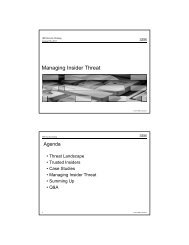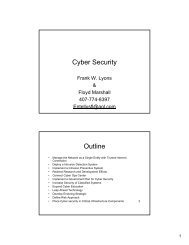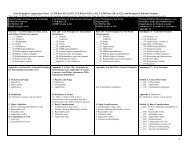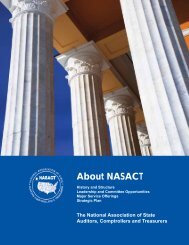- Page 5:
ADVISORY COMMITTEE ON TAX EXEMPT AN
- Page 9 and 10:
MEMBER BIOGRAPHIESGOVERNMENT ENTITI
- Page 11 and 12:
GENERAL REPORTOF THEADVISORY COMMIT
- Page 13:
General Report of the Advis
- Page 18:
Improving the Employee Plans Compli
- Page 23 and 24:
Improving the Employee Plans Compli
- Page 25 and 26:
Improving the Employee Plans Compli
- Page 27 and 28:
Improving the Employee Plans Compli
- Page 29 and 30:
Improving the Employee Plans Compli
- Page 31 and 32:
Improving the Employee Plans Compli
- Page 33 and 34:
Improving the Employee Plans Compli
- Page 35 and 36:
Improving the Employee Plans Compli
- Page 37 and 38:
Improving the Employee Plans Compli
- Page 39 and 40:
Improving the Employee Plans Compli
- Page 41 and 42:
Improving the Employee Plans Compli
- Page 43:
Improving the Employee Plans Compli
- Page 47 and 48:
Improving the Employee Plans Compli
- Page 49 and 50:
Improving the Employee Plans Compli
- Page 51 and 52:
Improving the Employee Plans Compli
- Page 53 and 54:
Improving the Employee Plans Compli
- Page 55 and 56:
Improving the Employee Plans Compli
- Page 57 and 58:
Improving the Employee Plans Compli
- Page 59 and 60:
Improving the Employee Plans Compli
- Page 61 and 62:
Improving the Employee Plans Compli
- Page 63 and 64:
Improving the Employee Plans Compli
- Page 65 and 66:
Improving the Employee Plans Compli
- Page 67 and 68:
Improving the Employee Plans Compli
- Page 69 and 70:
Improving the Employee Plans Compli
- Page 71 and 72:
EXHIBIT DSubmission Type:(insert fr
- Page 73 and 74:
EXHIBIT D (CONTINUED)18. Descriptio
- Page 75 and 76:
EXHIBIT D (CONTINUED)VCP CHECKLISTT
- Page 77 and 78:
EXHIBIT D (CONTINUED)23. Have you i
- Page 79 and 80:
EXHIBIT D (CONTINUED)Instructions f
- Page 81 and 82:
EXHIBIT D (CONTINUED)23. Under Exam
- Page 83 and 84:
ADVISORY COMMITTEE ONTAX EXEMPT AND
- Page 85:
The Appropriate Role Of The Interna
- Page 88 and 89:
The Appropriate Role Of The Interna
- Page 90 and 91:
The Appropriate Role Of The Interna
- Page 92 and 93:
The Appropriate Role Of The Interna
- Page 94 and 95:
The Appropriate Role Of The Interna
- Page 96 and 97:
The Appropriate Role Of The Interna
- Page 98 and 99:
The Appropriate Role Of The Interna
- Page 100 and 101:
The Appropriate Role Of The Interna
- Page 102 and 103:
The Appropriate Role Of The Interna
- Page 104 and 105:
The Appropriate Role Of The Interna
- Page 106 and 107:
The Appropriate Role Of The Interna
- Page 108 and 109:
The Appropriate Role Of The Interna
- Page 110 and 111:
The Appropriate Role Of The Interna
- Page 112 and 113:
The Appropriate Role Of The Interna
- Page 114 and 115:
The Appropriate Role Of The Interna
- Page 116 and 117:
The Appropriate Role Of The Interna
- Page 118 and 119:
The Appropriate Role Of The Interna
- Page 120 and 121:
The Appropriate Role Of The Interna
- Page 122 and 123:
The Appropriate Role Of The Interna
- Page 124 and 125:
The Appropriate Role Of The Interna
- Page 126 and 127:
The Appropriate Role Of The Interna
- Page 128 and 129:
The Appropriate Role Of The Interna
- Page 130 and 131:
The Appropriate Role Of The Interna
- Page 132 and 133:
The Appropriate Role Of The Interna
- Page 134 and 135:
The Appropriate Role Of The Interna
- Page 136 and 137:
The Appropriate Role Of The Interna
- Page 138 and 139:
The Appropriate Role Of The Interna
- Page 140 and 141:
The Appropriate Role Of The Interna
- Page 142 and 143:
The Appropriate Role Of The Interna
- Page 144 and 145:
The Appropriate Role Of The Interna
- Page 146 and 147:
The Appropriate Role Of The Interna
- Page 148 and 149:
The Appropriate Role Of The Interna
- Page 150 and 151:
The Appropriate Role Of The Interna
- Page 152 and 153:
The Appropriate Role Of The Interna
- Page 154 and 155:
The Appropriate Role Of The Interna
- Page 156 and 157:
The Appropriate Role Of The Interna
- Page 158 and 159:
The Appropriate Role Of The Interna
- Page 160 and 161:
The Appropriate Role Of The Interna
- Page 162 and 163:
The Appropriate Role Of The Interna
- Page 164 and 165:
The Appropriate Role Of The Interna
- Page 166 and 167:
The Appropriate Role Of The Interna
- Page 168 and 169:
The Appropriate Role Of The Interna
- Page 170 and 171:
The Appropriate Role Of The Interna
- Page 172 and 173:
The Appropriate Role Of The Interna
- Page 174 and 175:
The Appropriate Role Of The Interna
- Page 176 and 177:
The Appropriate Role Of The Interna
- Page 178 and 179:
The Appropriate Role Of The Interna
- Page 180 and 181:
The Appropriate Role Of The Interna
- Page 182 and 183:
The Appropriate Role Of The Interna
- Page 184 and 185:
The Appropriate Role Of The Interna
- Page 186 and 187:
The Appropriate Role Of The Interna
- Page 188 and 189:
The Appropriate Role Of The Interna
- Page 190 and 191:
The Appropriate Role Of The Interna
- Page 192 and 193:
The Appropriate Role Of The Interna
- Page 194 and 195:
The Appropriate Role Of The Interna
- Page 196 and 197:
The Appropriate Role Of The Interna
- Page 198 and 199:
The Appropriate Role Of The Interna
- Page 201:
The Streamlined Closing Agreement F
- Page 204 and 205:
The Streamlined Closing Agreement F
- Page 206 and 207:
The Streamlined Closing Agreement F
- Page 208 and 209:
The Streamlined Closing Agreement F
- Page 210 and 211:
The Streamlined Closing Agreement F
- Page 212 and 213:
The Streamlined Closing Agreement F
- Page 214 and 215:
The Streamlined Closing Agreement F
- Page 217:
ADVISORY COMMITTEE ONTAX EXEMPT AND
- Page 220 and 221:
PROTECTING PLAN BENEFITS:IMPROVING
- Page 222 and 223: PROTECTING PLAN BENEFITS:IMPROVING
- Page 224 and 225: PROTECTING PLAN BENEFITS:IMPROVING
- Page 226 and 227: PROTECTING PLAN BENEFITS:IMPROVING
- Page 228 and 229: PROTECTING PLAN BENEFITS:IMPROVING
- Page 230 and 231: PROTECTING PLAN BENEFITS:IMPROVING
- Page 232 and 233: PROTECTING PLAN BENEFITS:IMPROVING
- Page 234 and 235: PROTECTING PLAN BENEFITS:IMPROVING
- Page 236 and 237: PROTECTING PLAN BENEFITS:IMPROVING
- Page 238 and 239: PROTECTING PLAN BENEFITS:IMPROVING
- Page 240 and 241: PROTECTING PLAN BENEFITS:IMPROVING
- Page 242 and 243: PROTECTING PLAN BENEFITS:IMPROVING
- Page 244 and 245: PROTECTING PLAN BENEFITS:IMPROVING
- Page 246 and 247: PROTECTING PLAN BENEFITS:IMPROVING
- Page 248 and 249: PROTECTING PLAN BENEFITS:IMPROVING
- Page 250 and 251: PROTECTING PLAN BENEFITS:IMPROVING
- Page 252 and 253: PROTECTING PLAN BENEFITS:IMPROVING
- Page 254 and 255: PROTECTING PLAN BENEFITS:IMPROVING
- Page 256 and 257: PROTECTING PLAN BENEFITS:IMPROVING
- Page 259 and 260: PROTECTING PLAN BENEFITS:IMPROVING
- Page 261 and 262: PROTECTING PLAN BENEFITS:IMPROVING
- Page 263 and 264: PROTECTING PLAN BENEFITS:IMPROVING
- Page 265 and 266: PROTECTING PLAN BENEFITS:IMPROVING
- Page 267: ADVISORY COMMITTEE ONTAX EXEMPT AND
- Page 271: Tax Treatment Of Cellular Telephone
- Page 275 and 276: Tax Treatment Of Cellular Telephone
- Page 277 and 278: Tax Treatment Of Cellular Telephone
- Page 279 and 280: IRC, 2007-CODE-VOL, SEC. 280F. LIMI
- Page 281 and 282: PENIRC S 274 Page 1 of 12IIRC, 2007
- Page 283 and 284: PENIRC S 274 Page 3 of 12relationsh
- Page 285: Employee Cell Phones Page 1 of 1Emp
- Page 289 and 290: 15. Special Rules for Various Types
- Page 292: Withholding RequirementsACCOUNTING
- Page 299: ADVISORY COMMITTEE ONTAX EXEMPT AND
- Page 303 and 304: Governmental Relationship and Commu
- Page 305 and 306: Governmental Relationship and Commu
- Page 307 and 308: Governmental Relationship and Commu
- Page 309 and 310: Governmental Relationship and Commu
- Page 311 and 312: Governmental Relationship and Commu
- Page 313 and 314: Governmental Relationship and Commu
- Page 315 and 316: Governmental Relationship and Commu
- Page 317 and 318: Governmental Relationship and Commu
- Page 319 and 320: Governmental Relationship and Commu
- Page 321 and 322: Governmental Relationship and Commu
- Page 323 and 324:
Governmental Relationship and Commu
- Page 325 and 326:
Governmental Relationship and Commu
- Page 327 and 328:
Governmental Relationship and Commu













